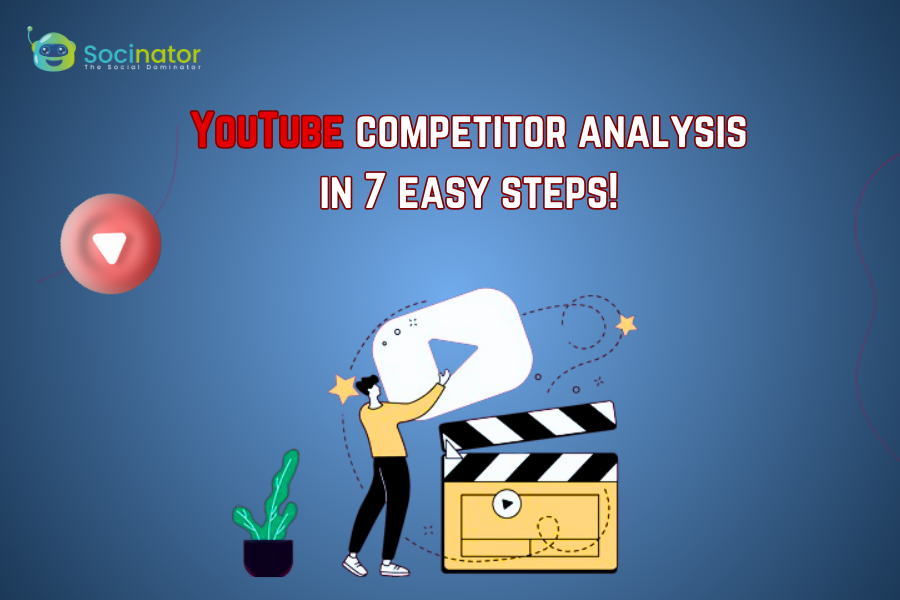The competition on YouTube is tough. There are creators from all over the world trying to get noticed. Over a billion people are using YouTube, and loads of new videos are uploaded all the time. It’s super challenging to stand out because there are so many videos to choose from. Channels that make similar content often compete with each other. They’re all trying to get people to watch their videos, subscribe to their channels, and become more popular on YouTube. Because of all these, analyzing competitors on YouTube becomes crucial.
By understanding what your competitors are doing well, you can identify opportunities for improvement, refine your content strategy, and stay ahead of the competition.
Creators have a lot of difficulties in this competition. They need to produce engaging videos that keep people interested and wanting more. They also must stay informed about popular trends and preferences to ensure their videos remain attractive to viewers.
Learning the YouTube algorithm and conducting competitor analysis could help the creators to make their videos meet more engaging. Thereby increasing the chances that their content will reach more viewers on YouTube.
In a hurry? Listen to the blog instead!
What Is YouTube Competitor Analysis?
YouTube competitor analysis involves researching and evaluating Youtube’s analytics, content, and strategies of other channels or creators within your niche or industry. It aims to gain insights into what your competitors are doing well. It identifies areas for improvement and understand trends and audience preferences within your niche.
Fundamental aspects of YouTube competitor analysis include:
- Content Quality Analysis: Examine the types of content your competitors are creating, their format, style, frequency of posting, and engagement metrics such as likes, comments, shares, and views.
- Audience Analysis: Understanding your competitors’ audience demographics, interests, and behaviors. It might involve age, gender, location, and engagement levels.
- SEO and Keyword Analysis: Analyzing your competitors’ use of keywords, tags, titles, and descriptions to optimize their videos for search and discoverability.
- Engagement Strategies: Identify how your competitors engage with their audience, respond to comments, collaborate with other creators. Evaluate how they leverage trends or challenges to increase engagement.
- Competitor Evaluation: Comparing your channel’s performance metrics (e.g., subscribers, views, watch time) with those of your competitors to assess your relative standing and identify areas of strength or weakness.
By conducting competitor analysis, you can refine your content strategy, stay informed about industry trends, and optimize your channel for growth and success on YouTube.
Benefits Of YouTube Competitor Analysis –
Analyzing competitors on YouTube offers several benefits:
- Find what is trending: By studying competitors, you can stay updated on current trends and changes within your niche or industry. Gain valuable insights into industry trends by analyzing competitor performance. It helps you stay informed about emerging trends and preferences within your niche, allowing you to adapt your strategy accordingly.
- Understanding Audience Preferences: Competitor analysis helps you recognize which content types connect with your target audience. This insight can inform your content creation process and help you produce videos that better meet the needs and preferences of your viewers.
- Optimize Content Gaps and Opportunities: By identifying areas where your competitors may be lacking or overlooking. You can capitalize on these gaps and create content that fills a need or provides a unique perspective within your niche.
- Aids in Improving SEO and Discoverability: Analyzing competitors’ use of keywords, tags, and titles can help you identify effective SEO strategies and elevate the discoverability of your videos on YouTube.
- Streamlines your marketing strategy: Optimize your YouTube marketing strategy with streamlined efficiency through competitor analysis. By examining the strategies and performance of your competitors, you can identify effective tactics, refine your approach, and avoid common pitfalls. This process streamlines your decision-making, enabling you to focus on proven methods and adapt quickly to changes.
- Stay ahead of the competition: Comparing your channel’s performance metrics with your competitors allows you to assess your standing in the market and identify areas for improvement. It can help you set realistic goals and track your progress over time.
By thoroughly reviewing how your competitors engage and promote their content, you can uncover effective strategies to introduce into your channel promotion efforts.
How To Perform YouTube Competitor Analysis?
Here are steps you can follow to conduct a YouTube competitor analysis:
Find your competitors:
Start by identifying channels or creators in your niche that produce similar content and target a similar audience. Clearly define the focus or theme of your YouTube channel to understand where you fit within the broader landscape.
Next, conduct keyword searches related to your niche to uncover channels that consistently rank well or appear in search results. Additionally, explore the “Recommended Channels” or “Suggested Channels” sections on YouTube to find channels that share similarities with yours.
Research Content:
Watch videos from your competitors to understand their content strategy, format, style, and production quality. Take note of popular topics, recurring themes, and video length. While viewing your competitors’ videos, carefully observe the storytelling methods they use. Consider how they structure their narratives, introduce conflicts, and resolve them.
Please take note of how they pace their videos and manage to sustain viewer interest throughout. Additionally, analyze the use of visual and auditory elements such as music, sound effects, graphics, and transitions to enhance the overall viewer experience. These storytelling and multimedia techniques can significantly influence audience engagement and retention. So, understanding how your competitors utilize them can provide valuable insights for refining your content strategy. Also, ensure you know how to verify your YouTube account, as it can unlock additional features to enhance your video production and engagement potential.
Analyze Engagement:
Evaluate the engagement metrics of your competitors’ videos, including likes, comments, shares, and views. Look for patterns and trends in engagement levels over time. When assessing engagement metrics, it’s crucial to consider both the raw numbers and the engagement rate in relation to the audience size.
For example, a video with 100 likes might seem impressive, but if it only has 200 views, the engagement rate is relatively low compared to a video with 100 likes and 10,000 views. Examining the demographics of the engaged audience can offer insights into the types of content that resonate with specific segments of viewers.
Additionally, observing how engagement metrics vary in response to alterations in content strategy, format, or topic can aid in recognizing cause-and-effect connections and shaping future decisions.
Keyword Performance Analysis:
Examine your competitors’ use of keywords, tags, titles, and descriptions to optimize their videos for search and discoverability. Identify the keywords they are ranking for and their search visibility.
In addition to examining these, examine how your competitors optimize their video thumbnails and metadata to maximize click-through rates and viewer engagement. Assess whether they use compelling imagery, text overlays, or branding elements to attract attention in search results and suggested videos.
Examine Engagement Strategies:
Identify how your competitors engage with their audience, respond to comments, collaborate with other creators. Also, optimize trends or challenges to increase engagement. Consider their overall approach to community management; are they actively soliciting feedback, asking questions, or running polls to involve their audience in content decisions? Additionally, assess how they handle criticism or negative feedback, as it can impact their reputation and credibility among viewers. Also, conduct a YouTube audit of your channel to see if your strategy works or not.
Benchmarking your YouTube channel’s performance:
It involves comparing key metrics such as subscribers, views, and watch time with those of your competitors within your niche. By identifying your competitors and gathering relevant data, you can analyze trends and understand where you excel or lag behind. This analysis helps you identify best practices employed by top-performing channels and set goals for improving your own performance. By continuously monitoring and adjusting your strategies based on competitor analysis, you can enhance your channel’s growth and competitiveness in the YouTube market.
Identify opportunities and refine your strategy:
Based on your analysis, identify opportunities for improvement and potential threats to your channel’s growth. It could include content gaps, emerging trends, or competitors gaining traction. Use the insights gained from your competitor analysis to refine your content strategy, optimize your channel for growth, and differentiate yourself in the market.
YouTube competitor analysis provides valuable insights that can help you improve your content strategy, stand out in the market, and optimize your channel for growth and success on YouTube.
Also read:
Time To Use YouTube Marketing Analytics Data To Create Scalable Videos
05 tips to grow your channel with youtube marketing tool
Analyze Competitors with YouTube Automation: –
YouTube automation resources have made it easier for marketers to check on engaging content ideas. These tools streamline data collection, allowing creators to swiftly gather vital metrics like subscriber count, views, engagement rates, and video performance across competitor channels.
By automating content monitoring, creators can effortlessly track competitor uploads and changes, staying informed of shifting strategies and emerging trends. Automation also facilitates keyword tracking, providing valuable insights into competitor SEO tactics and allowing for strategic optimization.
If you want to simplify your analysis, consider utilizing YouTube automation software such as Socinator, which can also aid in boosting your YouTube growth.
Socinator is primarily a social media automation tool that supports various platforms like Facebook, Instagram, Twitter, LinkedIn, Pinterest, YouTube, and Quora. It offers features for scheduling posts, engaging with followers, and managing multiple accounts across these platforms.
Automating your content and leveraging competitor analysis can significantly boost your YouTube growth. By scheduling and automating video uploads, you can maintain a consistent publishing schedule and reach your target audience at optimal times for engagement. This strategic YouTube marketing approach ensures that your content is delivered when your audience is most active, maximizing visibility and interaction opportunities.
You can also use it to manage comments and engagement on your YouTube channel. Socinator includes responding to comments, liking and moderating comments, and engaging with your audience. It helps to build a sense of good relationship with the audience. Also, it enhances engagement as a result of it.
It acts as a YouTube marketing tool that can be valuable for managing and optimizing your YouTube channel.
Conclusion: –
To sum it up, YouTube is a tough place to make it big because there are so many creators and videos. Everyone’s trying to get noticed and attract viewers. This makes it crucial to keep an eye on what others are doing.
Competitor analysis on YouTube means looking at what other creators are doing. It helps us see what works well and what we can do better. By checking out our rivals, we can get ideas to improve our content and stay ahead.
But it’s not easy. Creators have to make videos that people want to watch and keep up with what’s trending. Learning from our competitors and using tools like Socinator can make this process easier. By understanding what others are doing and automating some tasks, we can boost our chances of success on YouTube.










